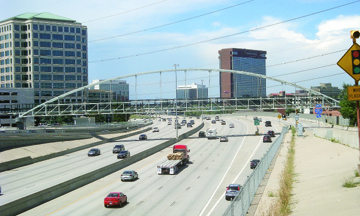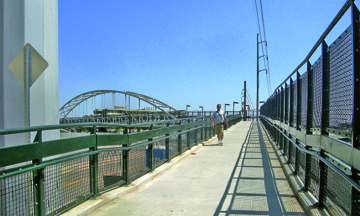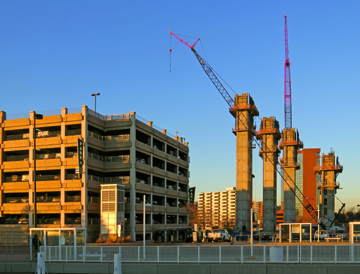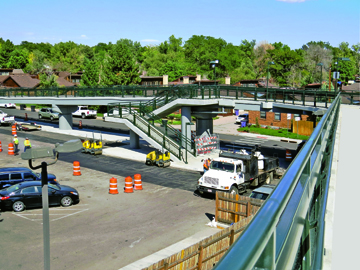 Residents Hate The Iconic Structure Designed To Gain Political Favor
Residents Hate The Iconic Structure Designed To Gain Political Favor
With Bike Advocacy Groups
A pedestrian and bicycle bridge that crosses over I-25 at Colorado Blvd. linking the area to the light rail station opened 16 years and $8 million after Denver initially contemplated the project. Since opening in July 2015 many are asking if the bridge is a benefit or boondoggle to an area that grew up in the golden age of automobiles?
As the neighborhood and surrounding business community has matured many are unsure whether being retrofitted for pedestrians, bicycles and public transit is a blessing. Developed mostly during the 1950s and 1960s, this established neighbor hood is an eclectic mix of single-family ranch homes, apartment buildings and townhomes, along with shopping centers and mid- to high-rise office buildings.
hood is an eclectic mix of single-family ranch homes, apartment buildings and townhomes, along with shopping centers and mid- to high-rise office buildings.
The initial reaction of many: They hate it! They are displeased and disturbed with the lack of parking spaces and believe the ramp is ugly. They are also unhappy with the increased noise and activity created by bicyclists and people going to and coming from work. Someone even wrote on the DownhomeDenver blog that there’s no reason for the bridge that was paid for with $4 million in City Capital Improvement Funds and $4 million in Federal Transportation Funds. Others, however, believe that the vast majority of residents other than the four or five buildings’ worth living at the base of the access ramp, approve of the bridge or have no opinion.
The north-south freeway previously separated inhabitants from the light rail link known as the Colorado Station. Now, however, the bridge connects the transit hub with Cherry St. and the Virginia Village neighborhood to the east. Access over I-25 is in the vicinity of Colorado Blvd. and East Evans Ave.
The bridge spans I-25, landing at Cherry St. to the north and RTD’s Colorado Station (light rail transit) to the south. The bridge was built to provide a safe way for bike riders and walkers to cross over I-25 without using Colorado Blvd., a street filled with rushing cars day and night. A biker named Bob stopped on the bridge by the Chronicle refused to give his last name but said he believes the bridge is worth every penny. He uses it fairly frequently now that he’s discovered it but can’t believe how few others do use it.
The bridge was theoretically built to increase connectivity to the Colorado Station, which boasted 5,600 arrivals and boarding per day prior to the bridge opening. That number hasn’t increased dramatically in the months since the opening. Only 2% of RTD’s ridership is by bike and at the Colorado Station that number hasn’t yet jumped appreciably. Most of those walking to the station don’t cross the bridge but are walking from the nearby parking lot.
Bicker With Bikers
For many the bridge also symbolizes the  increasing squabble between motorists and bikers due to Denver’s policy of being hostile to automobile drivers and friendly to bikers. Denver drivers are constantly in a state of irritation due to the City’s implementing of Denver Moves Bicycles, a network plan of installing protected bike lanes, installing bicycle detection and signal upgrades that speed cyclists ahead while slowing down auto traffic.
increasing squabble between motorists and bikers due to Denver’s policy of being hostile to automobile drivers and friendly to bikers. Denver drivers are constantly in a state of irritation due to the City’s implementing of Denver Moves Bicycles, a network plan of installing protected bike lanes, installing bicycle detection and signal upgrades that speed cyclists ahead while slowing down auto traffic.
Road Diets — a plan being advanced by Denver’s Planning Department — entails converting four-lane undivided roadways to two-lane roadways. Furthermore the plan provides for a two-way left turn lane by removing a travel lane in each direction. The remaining roadway width is converted to bike lanes. Staunch bicycle supporters argue that these road diets actually reduce overall traffic. Bicycling is growing beyond just being a part of Denver Public Work’s and Parks & Recreation programs. Denver added three full-time individuals to the bike program in 2014 to help implement bicycle projects and improvements.
Motorists complain that cyclists ride on their merry way oblivious to drivers, don’t obey traffic lights or anything or everyone else that get in their way. “They don’t look around, don’t care about their own safety or those of the people they are distracting,” says Cherry Creek resident Latasha Curry.
Engineering & Art
Work on the bridge began on March 17, 2014, with initial construction focusing on fabrication and installation of the steel pedestrian railing on the main span over I-25 and the approach spans on either side of I-25. The arch was successfully set into place on the night of Jan. 16, 2015. The installation of the railing on the main span started on the west side of the bridge and progressed to the east. Project lighting followed the progress of the steel railing.
The high point to completion of the bridge was construction of the concrete deck. The concrete was poured into a 309-foot long truss — a little longer than a football field — and weighed close to 200 tons. That’s equivalent to about 18,700 gallons of concrete and required 10 concrete trucks and two big “pumpers” to pour concrete into the truss. The work often required full overnight closure of I-25 from Colorado Blvd. to Evans Ave.
Artwork titled A Mindful Bridge by North Carolina artists Jim Hirschfield and Sonya Ishii was installed on the bridge during the week of Sept. 29-Oct. 3, 2015. They are an array of shimmering circular stainless steel disks attached to the interior of the bridge. The disks contain quotes about the experiences of people walking or cycling while crossing a bridge. A Denver ordinance enacted in 1991 directs that 1% of any capital improvement project over $1 million undertaken by the City be set aside for the inclusion of art in the design and construction of those projects.
Catalyst For Growth
Construction of the bridge has become a catalyst for new development within the area and more is anticipated. Lincoln Property Company and ASB Real Estate Investments are building a new mixed use development , adding more than 450,000 square feet of commercial and residential space to the nearby Colorado Center.
, adding more than 450,000 square feet of commercial and residential space to the nearby Colorado Center.
Real estate professionals suggest that the site has the potential to become Denver’s largest transit oriented development (TOD). Their point: With the light rail station plus the pedestrian-bicycle bridge, access to the site is unprecedented, creating a community center for the surrounding neighborhoods and I-25 corridor.
At the intersection of I-25 and Colorado Blvd. the additions will add 210,000 square-feet of office buildings plus a residential tower containing 189 apartments and 80 loft-style units. A 40,000 square foot Main Street retail section is also planned. The Center already features three office buildings plus the Dave & Busters-United Artists complex. New office space will add eight stories over five levels of parking. Retail space will be located within the residential development. Construction of the office space is expected to be complete in Dec. 2016 and the residential portion in mid-2017.

